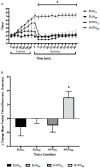The Utility of Thirst as a Measure of Hydration Status Following Exercise-Induced Dehydration
- PMID: 31703247
- PMCID: PMC6893511
- DOI: 10.3390/nu11112689
The Utility of Thirst as a Measure of Hydration Status Following Exercise-Induced Dehydration
Abstract
The purpose of this study was to examine the perception of thirst as a marker of hydration status following prolonged exercise in the heat. Twelve men (mean ± SD; age, 23 ± 4 y; body mass, 81.4 ± 9.9 kg; height, 182 ± 9 cm; body fat, 14.3% ± 4.7%) completed two 180 min bouts of exercise on a motorized treadmill in a hot environment (35.2 ± 0.6 °C; RH, 30.0 ± 5.4%), followed by a 60 min recovery period. Participants completed a euhydrated (EUH) and hypohydrated (HYPO) trial. During recovery, participants were randomly assigned to either fluid replacement (EUHFL and HYPOFL; 10 min ad libitum consumption) or no fluid replacement (EUHNF and HYPONF). Thirst was measured using both a nine-point scale and separate visual analog scales. The percent of body mass loss (%BML) was significantly greater immediately post exercise in HYPO (HYPOFL, 3.0% ± 1.2%; HYPONF, 2.6% ± 0.6%) compared to EUH (EUHFL, 0.2% ± 0.7%; EUHNF, 0.6% ± 0.5%) trials (p < 0.001). Following recovery, there were no differences in %BML between HYPOFL and HYPONF (p > 0.05) or between EUHFL and EUHNF (p > 0.05). Beginning at minute 5 during the recovery period, thirst perception was significantly greater in HYPONF than EUHFL, EUHNF, and HYPOFL (p < 0.05). A 10 min, ad libitum consumption of fluid post exercise when hypohydrated (%BML > 2%), negated differences in perception of thirst between euhydrated and hypohydrated trials. These results represent a limitation in the utility of thirst in guiding hydration practices.
Keywords: assessment; exercise; fluid replacement; hypohydration; perception.
Conflict of interest statement
The authors declare no conflicts of interest for the submitted work. In addition, the sponsor had no role in the design, execution, interpretation, or writing of the study.
Figures



Comment in
-
Comment on: "The Utility of Thirst as a Measure of Hydration Status Following Exercise-Induced Dehydration".Nutrients. 2020 Jan 14;12(1):215. doi: 10.3390/nu12010215. Nutrients. 2020. PMID: 31947620 Free PMC article.
References
-
- Cheuvront S.N., Kenefick R.W. Dehydration: Physiology, Assessment, and Performance Effects. Compr. Physiol. 2014;4:257–285. - PubMed
Publication types
MeSH terms
Substances
Grants and funding
LinkOut - more resources
Full Text Sources
Medical

